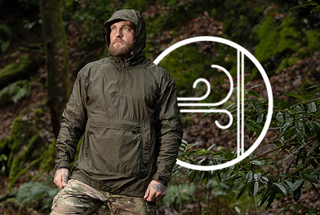The problem of wind
Wind chill is a type of forced convection, where heat is transferred through moving air. Your body generates heat, creating a warm layer of air around your skin. Wind disrupts this layer and replaces it with cooler air, increasing the rate at which your body loses heat and making it feel colder than the actual air temperature.
The faster the wind, the more heat is lost, intensifying the chill. Even if the air temperature isn’t dangerously low, wind chill can make conditions feel much colder, increasing the risk of frostbite or hypothermia.
While wind chill makes it feel colder, it doesn’t lower the temperature of objects. It only affects the body’s ability to retain heat, emphasising the importance of dressing appropriately in cold, windy conditions.
How to counter it
In a military clothing system, the wind layer serves as a lightweight, and stowable, protective barrier designed to shield the wearer from the convective effects of wind chill.
Wind Protection and Thermal Retention:
The wind layer blocks wind from penetrating inner layers, preventing heat from being swept away through convection. In cold environments, this wind-blocking layer preserves body heat, significantly improving comfort and operational capability.
Lightweight, Packable Design:
Wind layers are typically made from lightweight, tightly woven materials like nylon or polyester. This makes them compact and easy to carry, allowing soldiers to add wind protection as needed without significant bulk or weight it is common for wind layers to be carried on webbing/belt kit, or in patrol bags so this lightweight and packable design is essential.
Enhanced Mobility:
Wind layers need to be flexible, loose enough to be worn over base and field layers without restricting movement, without becoming baggy and interfering in movement. This is critical in combat scenarios where soldiers need to move quickly and efficiently.
Layering Compatibility:
The wind layer is normally worn over base layers and under heavier insulating or waterproof layers. This modular approach allows soldiers to adjust clothing to changing conditions, such as moving from windy to wet weather, or from a cold morning to a warmer afternoon.
Quick-Drying and Moisture Management:
Wind layers are commonly made from either water-repellent or quick-drying materials, offering limited protection against light rain. This reduces the risk of water soaking through to the inner layers.
Combat-proven and respected, the wind layer in military clothing systems is a versatile piece essential to maintaining comfort and performance in the field and rightfully belongs in every operator layering system.
Enter the Hurricane
The Hurricane blocks wind from penetrating inner layers, preventing heat from being swept away through convection. In cold environments, this wind-blocking layer preserves body heat, significantly improving comfort and operational capability.
The Hurricane is made from 100% Nylon 70D Ripstop. This makes it lightweight, compact and easy to carry, allowing soldiers to add wind protection as needed without significant bulk or weight.
It's also flexible, loose enough to be worn over base and field layers without restricting movement. This is critical in combat scenarios where soldiers need to move quickly and efficiently, and allows them to adjust clothing to changing conditions.
The Hurricane also boasts our Durable Water Resistant finish (DWR), offering protection against light rain. This reduces the risk of water soaking through to the inner layers.

The Hurricane arrives in store soon in Black, Ranger Green, and MultiCam.



